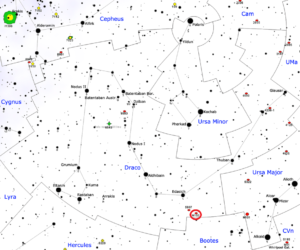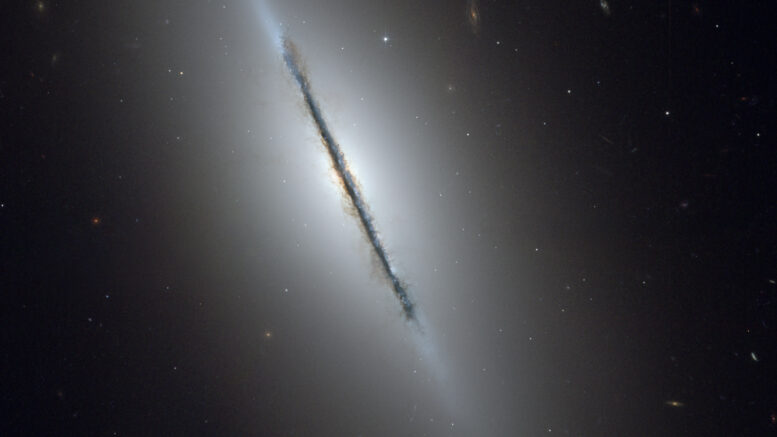Messier 102 (M102), also known as the Spindle Galaxy, is an edge-on lenticular galaxy located in the northern constellation Draco. Observers in the Pacific Northwest can view the galaxy throughout the year as it is circumpolar and never sets below the horizon.There is some controversy over the discovery of M102 as some say that M102 matches the object provided at the coordinates of Messier, but others think these coordinates are pointing to M101.
| Description | |
| Visible From Pacific Northwest | April To September |
| Best Time To Observe | July |
| Minimum Size Of Viewing Device | Small Telescope |
| Object Type | Lenticular Galaxy |
| Designations | Messier 102, M102, NGC 5866, Spindle Galaxy, PGC 53933, UGC 9723, 1E 1505.1+5557, IRAS 15051+5557, 2MASX J15062956+5545479, MCG+09-25-017, UZC J150629.4+554548, Z 274-16, Z 1505.1+5557 |
| Right Ascension | 15h 06m 29.5s |
| Declination | +55°45’48” |
| Constellation | Draco |
| Number Of Stars | 100 Billion |
| Apparent magnitude | +10.7 |
| Apparent dimensions | 4′.7 x 1′.9 |
| Object Radius | 30,000 light years |
| Distance From Earth | 50,000,000 light years |
History
The Spindle Galaxy was most likely discovered either by Pierre Méchain or Charles Messier in 1781. Méchain documented M102 in late March or early April, 1781, describing the object as a “nebula between the stars Omicron Boötis & Iota Draconis,” adding that “it is very faint; near it is a star of the sixth magnitude.” Méchain probably meant Theta Boötis, not Omicron, which contributed to the confusion around the identity of M102. Omicron Boötis is more than 40 degrees away from Iota Draconis, which makes the possibility of an error very likely.
Méchain reported the discovery to Messier, who added the object to his catalogue without providing a position. Messier later gave a handwritten position for M102 in his personal copy.
The Spindle Galaxy was independently discovered by William Herschel in 1788. Herschel determined the position of the object on May 5, 1788 and catalogued it as H I.215, describing it as “very bright. Considerably large. Extended. Following [east of] 2 stars.”
John Herschel catalogued the object as h 1909, but made a mistake in referring to it as William Herschel’s H I.219 instead of H 1.215. He described it as “very bright; pretty much elongated; gradually brighter toward the middle; 50″ long, 20″ broad; extended along position angle 326 [= 146] by micrometer.”
Herschel later corrected the error and included the object in his General Catalogue as GC 4058.
Locating M102 In The Sky
The Spindle Galaxy can be found east of the Big Dipper, in the southern part of Draco. It is located 4 degrees southwest of the magnitude 3.3 red giant star Iota Draconis, in the direction of Alkaid, Eta Ursae Majoris, the star that marks the tip of the Big Dipper‘s handle. The best time of year to observe M102 is during the spring. Observers north of latitude 35N can see the galaxy throughout the year as it is circumpolar and never sets below the horizon.

Viewing M102
It is very difficult to see with binoculars, but easily visible in small telescopes, which show a thin, nebulous patch under good conditions. 4-inch telescopes show a bright elliptical nebulous patch with a brighter core, while 6-inch and 8-inch instruments reveal a halo of light and hints of the galaxy’s dark dust lane. Larger telescopes show the galaxy’s well-defined bright centre and more details of its structure.
Photographing M102
The key to obtaining a great photo of M102, is to utilize a larger telescope to resolve the details. The will require using accurate guiding systems, and a more advanced camera and editing, but it will be worth it. Several hours of capture using RGB filters as will really help bring out the color.
Sources And Further Reading
Descriptions of all of Messier Objects can be found here.
https://www.nasa.gov/feature/goddard/2017/messier-102-the-spindle-galaxy

Be the first to comment on "Messier 102 The Spindle Galaxy"